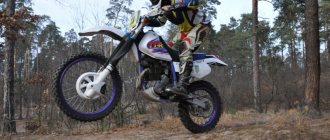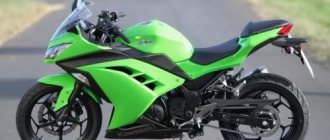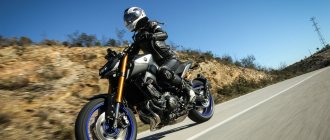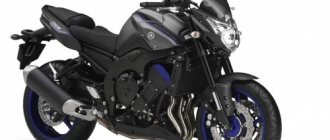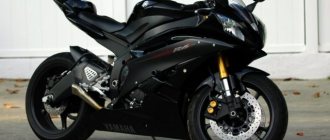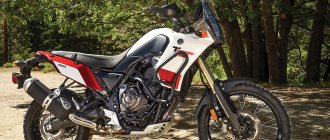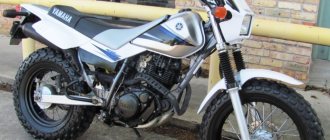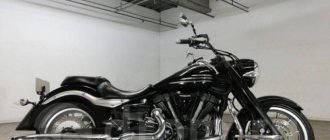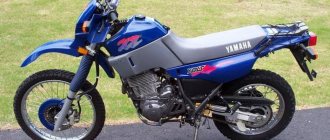- motorcycle model, Yamaha brand,
The Yamaha XJ6 Diversion road motorcycle model appeared on the market in 2009 on the basis of the Yamaha FZ6 naked bike and as a modern successor to the Yamaha XJ600S Diversion. Unlike the FZ6, the XJ6 received more modest equipment and, accordingly, a more affordable price.
Engine. Uses different camshafts and settings, which reduces maximum power to 78 hp.
Frame. The expensive aluminum frame was replaced with a simpler steel one.
Brakes. Instead of 4-piston calipers, simpler 2-piston ones were installed.
Fuel tank. Reduces its capacity from 19.4 to 17.3 liters.
Initially, 2 modifications of the XJ6 model were presented:
Yamaha XJ6N - naked version.
Yamaha XJ6S Diversion - version with front fairing.
Since 2010, a completely plastic modification of the Yamaha XJ6F Diversion has appeared, which is sold on the American market under the name Yamaha FZ6R.
The features of the XJ6 series motorcycles include a steel diagonal frame, an injection power system, the availability of versions with ABS, simple suspension in the form of a conventional telescopic fork at the front and a monoshock absorber at the rear, a 6-speed gearbox and a curb weight of 205 kg (the lightest weight is the XJ6N without ABS ).
2016 was the last year of production of the series for the European market, and in 2021 the model finally left the North American market.
Dimensions and weight
The XJ6 Diversion is neither a heavy nor a very light naked bike. Its weight together with 17 liters of fuel is 211 kg. The dimensions of the model are also average: the wheelbase is insignificant - 1440 mm, and the seat height is 785 mm. A motorcycle consumes an average of 6 liters of gasoline per hundred kilometers; This is not much, but it is important to remember that with aggressive driving, fuel consumption can increase significantly.
Brief history of the model
2009 - start of production and sales of XJ6N and XJ6S. Model: Yamaha XJ6N + ABS; Yamaha XJ6S + ABS (Europe). Factory designation: 20S1, 20S2 + 36B1; 36C1 + 36D1.
2010 - the appearance of the “plastic” modification of the XJ6F. In the North American market it is sold as the FZ6R. Model: Yamaha XJ6N + ABS; Yamaha XJ6S + ABS; Yamaha XJ6F / FZ6R + ABS (Europe, North America). Factory designation: 20S5, 20SA + 36B2, 36B3; 36C4 + 36D2; 1CW1, 36P9, 36PC, 1CW4 + 1DG1.
2011 - no significant changes. Model: Yamaha XJ6N + ABS; Yamaha XJ6S + ABS; Yamaha XJ6F / FZ6R + ABS (Europe, North America). Factory designation: 20SB + 36B4; 36C6 + 36D3; 1CW8, 36PJ, 36PF + 1DG2.
2012 - S and N versions are temporarily not produced. Model: Yamaha XJ6F / FZ6R (Europe, North America). Factory designation: 36PR, 36PM.
2013 - no significant changes. Model: Yamaha XJ6N + ABS; Yamaha XJ6S + ABS; Yamaha XJ6F / FZ6R + ABS (Europe, North America). Factory designation: 20SF, 20SJ, 20SL, 20SM + 36B5, 36B6, 36B7, 36B8; 36CB, 36C9 + 36D5, 36D7; 1CWJ, 1CWG, 36PX, 36PU + 1DG3, 1DG4.
2014 - no significant changes. Model: Yamaha XJ6N + ABS; Yamaha XJ6S + ABS; Yamaha XJ6F / FZ6R + ABS (Europe, North America). Factory designation: 20SV, 20SU, 20ST, 20SR + 36BC, 36BB, 36BA, 36B9; 36CC, 36CE + 36DA, 36D8; 2SR3, 2SR6, 1CWN, 1CWP + 1DG5, 1DG6.
2015 - no significant changes. Model: Yamaha XJ6N + ABS; Yamaha XJ6S + ABS; Yamaha XJ6F / FZ6R + ABS (Europe, North America). Factory designation: B611, B612 + 36BD, 36BE; 36CH, 36CF + 36DB, 36DD; 1CWV, 1CWW, 2SR9 + 1DG7, 1DG8.
2016 is the last year of production for the European market. Model: Yamaha XJ6N + ABS; Yamaha XJ6S + ABS; Yamaha XJ6F / FZ6R + ABS (Europe, North America). Factory designation: B617, B618, B619, B61A + 36BJ, 36BH, 36BG, 36BF; 36CJ, 36CK, 36CL, 36CM + 36DK, 36DH, 36DG, 36DE; BS11, BS12, BS13, BS14, 2SRC + 1DGA, 1DGB, 1DGC, 1DGD.
2017 is the last year of production for the North American market. Model: Yamaha FZ6R (Diversion F) (North America). Factory designation: 2SRF.
History of changes
Despite the long production period, the XJ6 Diversion has not undergone significant changes. However, something happened in his biography, and a sports version was released, in the name of which the letter “F” appeared at the end.
To summarize, we should note the main advantages of the XJ6 Diversion, including:
- reliability and simplicity;
- maneuverability and lightness;
- comfortable fit;
- durable engine;
- good wind protection, which, by the way, can be strengthened.
The XJ6 Diversion can compete with many mid-range naked bikes that have a much later release date. An excellent choice for experienced and not so experienced bikers who can handle a 600cc motorcycle.
Specifications:
| Model | Yamaha XJ6 Diversion |
| Motorcycle type | naked (XJ6N) / sports tourer (XJ6S, XJ6F) |
| Year of issue | 2009-2017 |
| Frame | steel diagonal |
| engine's type | 4-cylinder, 4-stroke, in-line |
| Working volume | 600 cm³ |
| Bore/Stroke | 65.5 x 44.5 mm |
| Compression ratio | 12.2:1 |
| Cooling | liquid |
| Number of valves per cylinder | DOHC, 4 valves per cylinder |
| Fuel supply system | Injector, 4x 32 mm |
| Ignition type | digital transistor (TCI) |
| Maximum power | 77.5 hp (57 kW) at 10000 rpm |
| Maximum torque | 59.7 Nm (6.1 kg*m) at 8000 rpm |
| Transmission | 6-speed |
| type of drive | chain |
| Front tire size | 120/70ZR 17M/C (58W) |
| Rear tire size | 160/60ZR 17M/C (69W) |
| Front brakes | 2 discs, 298 mm, 2-piston calipers (optional ABS) |
| Rear brakes | 1 disc, 245 mm, 2-piston caliper (optional ABS) |
| Front suspension | 41 mm telescopic fork, travel - 130 mm |
| Rear suspension | Pendulum with monoshock absorber (preload adjustment), stroke - 130 mm |
| Motorcycle length | 2120 mm |
| Motorcycle width | 770 mm |
| Motorcycle height | 1085 mm – XJ6N 1210 mm – XJ6S 1185 mm – XJ6F |
| Wheelbase | 1440 mm |
| Seat height | 785 mm |
| Minimum ground clearance (clearance) | 140 mm |
| Acceleration to 100 km/h | 4.15 sec |
| Maximum speed | 207 km/h |
| Gas tank capacity | 17.3 l (including reserve - 3.2 l) |
| Motorcycle weight (curb) | 205 kg – XJ6N 210 kg – XJ6NA 211 kg – XJ6S 216 kg – XJ6SA 215 kg – XJ6F 220 kg – XJ6FA |
Measurement results
| KAWASAKI ER-6F (2010) | YAMAHA XJ6 DIVERSION (2010) | |
| MAX. SHAFT POWER | 63.2 HP AT 8750 RPM | 65.7 HP AT 9250 RPM |
| MAX. POWER AT THE WHEEL | 69.3 HP AT 8750 RPM | 72.1 HP AT 9250 RPM |
| MAX. TORQUE ON SHAFT | 60 NM AT 7250 RPM | 53.3 NM AT 8250 RPM |
| MAX. TORQUE ON WHEEL | 64.5 NM AT 7250 RPM | 58.4 NM AT 8250 RPM |
| SPECIFIC SHAFT POWER | 106.7 HP/LITER | 120.2 HP/LITER |
| ACCELERATION | ||
| 0-100 M | 119.2 KM/H IN 5.165 S | 117.5 KM/H IN 5.253 S |
| 0-200 M | 148 KM/H IN 7.848 S | 144.9 KM/H IN 7.964 S |
| 0-300 M | 164.4 KM/H IN 10.144 S | 161.3 KM/H IN 10.293 S |
| 0-400 M | 176.6 KM/H IN 12.253 S | 172.7 KM/H IN 12.452 S |
| PERFORMANCE CHARACTERISTICS | ||
| MAX. SPEED | 207.1 km/h | 201.8 km/h |
| WEIGHT WITHOUT FUEL | 196.6 KG (98.4 FRONT; 98.2 REAR) | 202.2 KG (101.4 FRONT; 100.8 REAR) |
| FUEL CONSUMPTION IN THE CITY | 6.1 L/100 KM | 6.3 L/100 KM |
| IN THE COUNTRY | 5.7 L/100 KM | 5.9 L/100 KM |
| AT SPEED 130 KM/H | 5.9 L/100 KM | 6.2 L/100 KM |
“The ER-6f engine reaches peak power at 8500 rpm, however, from 7500 rpm the dynamics of horsepower growth drops. At higher operating modes, the Diversion engine is ahead of its competitor in power, but not in torque."
Taken from BIKE magazine No. 4/2010
Overview of modifications
The XJ6 Diversion model became a kind of continuation of the more powerful Yamaha FZ6 and replaced it in the European markets. In America it is sold under the name FZ6R.
It was produced almost from the very beginning in three versions: a basic one with a front fairing, without a front fairing with the index N in the model designation, and in a sports version, designated by the letter F.
The model in all variants was restyled in 2013.
The side panels have been redesigned, and changes have been made to the headlight fairing, passenger handles and LED instrument panel lighting. Yellow color has been removed from the color options; the basic version can be equipped with an ABS anti-lock braking system as an additional option. The saddle received a new leather trim, and the turn signals received new lenses. The chain tension system position indicator appears.
At the same time, Yamaha released a limited edition XJ 6 SP Dark Menace. It differs only in the spectacular carbon fiber finish, combined and six on the fairings.
Review of the Yamaha XJ6 Diversion motorcycle
On my sabotage I went on a long-distance trip to Kazan - I left in the morning at 8:00 and returned back in the evening. The total was 1161 km per day. Average speed 120-150.
Among the disadvantages for long-distance travel, I noted the following:
1) the standard glass is very low, you had to bend down, and driving in a bent state is difficult for a long time. The air flow from the glass falls directly into the neck under the helmet, causing constant monotonous aerodynamic noise inside - if anyone goes long distance, I recommend that you go with earplugs. On the way back I couldn’t stand it, I stopped at a gas station and asked some cotton wool to make plugs. It helped a little, but polyurethane ones are still better. 2) Still, the chain drive is not for long trips.
Before the trip, I lubricated mine with Motul overnight, but when I arrived back, naturally the chain was a bit dry, which means, ideally, you need to carry a bottle of chain lubricant with you so as not to ruin it quickly. On the plus side:
1) The dynamics were more than enough for me during the entire journey - any overtaking was very easy. The motorcycle holds 120 easily and shoots if necessary. 2) At speed it behaves stable and predictable. And in general, the handling is excellent! Once, in a turn after leaving a bridge uphill at speed, I caught a significant wobble, but fortunately I had read before how to behave when wobbling and did not lean on the steering wheel - the motorcycle righted itself! :)) I got enough thrills! 2) Very comfortable fit - sitting straight with earplugs in your ears you get incredible pleasure - the most comfortable and best fit for long-distance driving!
And in general, the handling is excellent! Once, in a turn after leaving a bridge uphill at speed, I caught a significant wobble, but fortunately I had read before how to behave when wobbling and did not lean on the steering wheel - the motorcycle righted itself! :)) I got enough thrills! 2) Very comfortable fit - sitting straight with earplugs in your ears you get incredible pleasure - the most comfortable and best fit for long-distance driving!
The first time I saw this Yamaha model was in Germany, near one of the motorcycle dealerships, and I can say that I fell in love with it. The strict and stylish appearance was captivating. Before that, I had my eye on the Honda Hornet and the Suzuki Bandit, but when I got on the Yamaha and took it for a ride, I immediately decided that there was no point in overpaying for competitors. Bought - in a word. I have a model with ABS. I have already appreciated all the advantages of this system several times... The dynamics, throttle response are quite sufficient, the gears are selected so that it “goes” to any. It is very easy and obedient to control. The appearance leaves no one indifferent - everyone likes it! Another big plus for me is that the silencer is hidden and does not stick out to the side like the “Bandit”, for example. The fact is that I keep a Yamaha in the garage and the car is also parked there. A protruding silencer would definitely create problems, but this designer model hid it very cleverly. The sound of the motor is very smooth and soft, instantly turning into a howl when moving the handle... No technical problems, good and reliable equipment! Both in the city and outside the city - the best driving experience.
The XJ6 of any modification is ideal as a first motorcycle for a novice motorcyclist and a fairly experienced driver:
It is easy to operate and at the same time remarkably controllable. It forgives mistakes, but can also be a pleasure for an experienced motorcyclist.
It is convenient and at the same time versatile. He feels equally good in traffic jams between the rows and on country roads.
It is incredibly reliable and at the same time does not require close attention and frequent maintenance.
It is powerful enough to feel confident on the track, but gently limits sudden “impulses of feelings.”
The engine is very elastic and has linear characteristics, and at the same time allows you to feel what “pickup” is.
